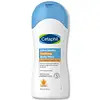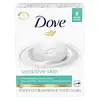What's inside
What's inside
 Key Ingredients
Key Ingredients

No key ingredients
 Benefits
Benefits

 Concerns
Concerns

 Ingredients Side-by-side
Ingredients Side-by-side

Water
Skin ConditioningGlycerin
HumectantSodium Laureth Sulfate
CleansingCocamidopropyl Betaine
CleansingDisodium Laureth Sulfosuccinate
CleansingBetaine
HumectantCalendula Officinalis Flower Extract
MaskingAloe Barbadensis Leaf Juice Powder
Skin ConditioningPanthenol
Skin ConditioningParfum
MaskingGlycol Distearate
EmollientAcrylates/C10-30 Alkyl Acrylate Crosspolymer
Emulsion StabilisingLauryl Lactate
EmollientCitric Acid
BufferingSodium Benzoate
MaskingPhenoxyethanol
PreservativeSodium Citrate
BufferingLaureth-4
EmulsifyingHydrolyzed Wheat Protein
Skin ConditioningHeliotropine
MaskingPolyquaternium-10
Sodium Hydroxide
BufferingWater, Glycerin, Sodium Laureth Sulfate, Cocamidopropyl Betaine, Disodium Laureth Sulfosuccinate, Betaine, Calendula Officinalis Flower Extract, Aloe Barbadensis Leaf Juice Powder, Panthenol, Parfum, Glycol Distearate, Acrylates/C10-30 Alkyl Acrylate Crosspolymer, Lauryl Lactate, Citric Acid, Sodium Benzoate, Phenoxyethanol, Sodium Citrate, Laureth-4, Hydrolyzed Wheat Protein, Heliotropine, Polyquaternium-10, Sodium Hydroxide
 Reviews
Reviews

Ingredients Explained
These ingredients are found in both products.
Ingredients higher up in an ingredient list are typically present in a larger amount.
Cocamidopropyl Betaine is a fatty acid created by mixing similar compounds in coconut oil and dimethylaminopropylamine, a compound with two amino groups.
This ingredient is a surfactant and cleanser. It helps gather the dirt, pollutants, and other impurities in your skin to be washed away. It also helps thicken a product and make the texture more creamy.
Being created from coconut oil means Cocamidopropyl Betaine is hydrating for the skin.
While Cocamidopropyl Betaine was believed to be an allergen, a study from 2012 disproved this. It found two compounds in unpure Cocamidopropyl Betaine to be the irritants: aminoamide and 3-dimethylaminopropylamine. High-grade and pure Cocamidopropyl Betaine did not induce allergic reactions during this study.
Learn more about Cocamidopropyl BetaineGlycerin is already naturally found in your skin. It helps moisturize and protect your skin.
A study from 2016 found glycerin to be more effective as a humectant than AHAs and hyaluronic acid.
As a humectant, it helps the skin stay hydrated by pulling moisture to your skin. The low molecular weight of glycerin allows it to pull moisture into the deeper layers of your skin.
Hydrated skin improves your skin barrier; Your skin barrier helps protect against irritants and bacteria.
Glycerin has also been found to have antimicrobial and antiviral properties. Due to these properties, glycerin is often used in wound and burn treatments.
In cosmetics, glycerin is usually derived from plants such as soybean or palm. However, it can also be sourced from animals, such as tallow or animal fat.
This ingredient is organic, colorless, odorless, and non-toxic.
Glycerin is the name for this ingredient in American English. British English uses Glycerol/Glycerine.
Learn more about GlycerinWater. It's the most common cosmetic ingredient of all. You'll usually see it at the top of ingredient lists, meaning that it makes up the largest part of the product.
So why is it so popular? Water most often acts as a solvent - this means that it helps dissolve other ingredients into the formulation.
You'll also recognize water as that liquid we all need to stay alive. If you see this, drink a glass of water. Stay hydrated!
Learn more about Water